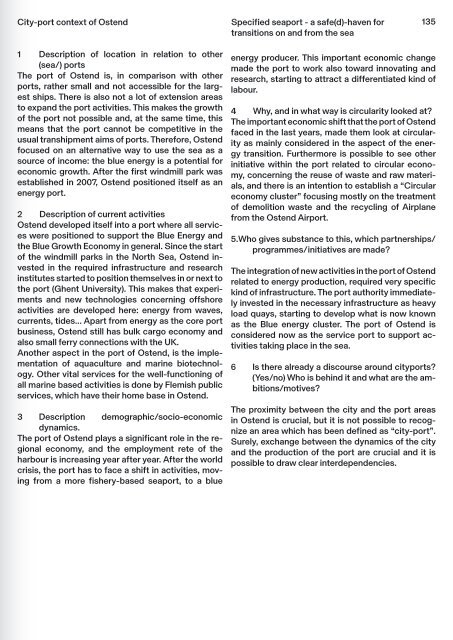Circular City Ports - Workbook
Create successful ePaper yourself
Turn your PDF publications into a flip-book with our unique Google optimized e-Paper software.
<strong>City</strong>-port context of Ostend<br />
Specified seaport - a safe(d)-haven for<br />
transitions on and from the sea<br />
135<br />
1 Description of location in relation to other<br />
(sea/) ports<br />
The port of Ostend is, in comparison with other<br />
ports, rather small and not accessible for the largest<br />
ships. There is also not a lot of extension areas<br />
to expand the port activities. This makes the growth<br />
of the port not possible and, at the same time, this<br />
means that the port cannot be competitive in the<br />
usual transhipment aims of ports. Therefore, Ostend<br />
focused on an alternative way to use the sea as a<br />
source of income: the blue energy is a potential for<br />
economic growth. After the first windmill park was<br />
established in 2007, Ostend positioned itself as an<br />
energy port.<br />
2 Description of current activities<br />
Ostend developed itself into a port where all services<br />
were positioned to support the Blue Energy and<br />
the Blue Growth Economy in general. Since the start<br />
of the windmill parks in the North Sea, Ostend invested<br />
in the required infrastructure and research<br />
institutes started to position themselves in or next to<br />
the port (Ghent University). This makes that experiments<br />
and new technologies concerning offshore<br />
activities are developed here: energy from waves,<br />
currents, tides... Apart from energy as the core port<br />
business, Ostend still has bulk cargo economy and<br />
also small ferry connections with the UK.<br />
Another aspect in the port of Ostend, is the implementation<br />
of aquaculture and marine biotechnology.<br />
Other vital services for the well-functioning of<br />
all marine based activities is done by Flemish public<br />
services, which have their home base in Ostend.<br />
3 Description demographic/socio-economic<br />
dynamics.<br />
The port of Ostend plays a significant role in the regional<br />
economy, and the employment rete of the<br />
harbour is increasing year after year. After the world<br />
crisis, the port has to face a shift in activities, moving<br />
from a more fishery-based seaport, to a blue<br />
energy producer. This important economic change<br />
made the port to work also toward innovating and<br />
research, starting to attract a differentiated kind of<br />
labour.<br />
4 Why, and in what way is circularity looked at?<br />
The important economic shift that the port of Ostend<br />
faced in the last years, made them look at circularity<br />
as mainly considered in the aspect of the energy<br />
transition. Furthermore is possible to see other<br />
initiative within the port related to circular economy,<br />
concerning the reuse of waste and raw materials,<br />
and there is an intention to establish a “<strong>Circular</strong><br />
economy cluster” focusing mostly on the treatment<br />
of demolition waste and the recycling of Airplane<br />
from the Ostend Airport.<br />
5.Who gives substance to this, which partnerships/<br />
programmes/initiatives are made?<br />
The integration of new activities in the port of Ostend<br />
related to energy production, required very specific<br />
kind of infrastructure. The port authority immediately<br />
invested in the necessary infrastructure as heavy<br />
load quays, starting to develop what is now known<br />
as the Blue energy cluster. The port of Ostend is<br />
considered now as the service port to support activities<br />
taking place in the sea.<br />
6 Is there already a discourse around cityports?<br />
(Yes/no) Who is behind it and what are the ambitions/motives?<br />
The proximity between the city and the port areas<br />
in Ostend is crucial, but it is not possible to recognize<br />
an area which has been defined as “city-port”.<br />
Surely, exchange between the dynamics of the city<br />
and the production of the port are crucial and it is<br />
possible to draw clear interdependencies.


















